Context:
In the most obvious way cosmology is the study of the cosmos. More helpfully it can be described as the study of the origins and evolution of the universe. All of which is probably a reflection of our innate human desire to understand where we come from and where we are going. Cosmology is embedded in most belief systems for just this reason. We will explore various aspects of current thinking about how our universe came to be and how it might 'end'. This is another enourmous subject and we will pick on some subset of the discipline in an effort to understand how the processes of science impact our models.
A Starting Place:
Activity: Cosmology starts to come close to deeply personal perspectives on the universe in which we find ourselves. As you discuss these questions please be respectful of the thoughts of others in your group. At the same time remember we, in this class, are viewing the world around us through the lens of science which has as it's basic assumption that there are descernable reasons why the universe is as it is. Your personal perspective is legitimately yours but I am asking for your thoughts and perspectives on both the data and the philosophy embedded in these fundamental questions.
Does the universe need to have a begining and end? Prominent astrophysicists have had all possible answers to this question in the last 100 years.
Are there reasons to believe that, at least at some level, planets, stars, and galaxies change over time?
At some level we are 'trapped' in this moment of time. How can we 'see' the universe at different stages of it's life?
What possible universe might we see if we could look back 5 Gyr (billion) years? Consider the options.
Turtles:
There are many versions of the 'turtle' story and I find the one quoted in Steven Hawking's book 'A Brief History of Time' to be as good as any.
“Stephen Hawking opens his new book with a marvelous old anecdote. A famous astronomer, after a lecture, was told by an elderly lady, who was perhaps under the influence of Hinduism, that his cosmology was all wrong. The world, she said, rests on the back of a giant tortoise. When the astronomer asked what the tortoise stands on, she replied: ‘You’re very clever, young man, very clever. But it’s turtles all the way down.’
Most people, Hawking writes, would find this cosmology ridiculous, but if we take the turtles as symbols of more and more fundamental laws, the tower is not so absurd. There are two ways to view it. Either a single turtle is at the bottom, standing on nothing, or it’s turtles all the way down. Both views are held by leading physicists.
There are certainly many ways to approach the challenge of the infinite chain of 'turtles'. One is to try to find the bottom of the stack and build one's way back to the top. Another is to seek to understand the next turtle in the stack and build our way towards the bottom. Other options exist as well. For our discussions I think it's more useful, though not necessarily correct, to build downwards as far as we can for now.
It has to be said that when we arrive at these large discussions of cosmology we also arrive at a place where the universe of the smallest bits of the universe shows up to meet us. Historically this was a relatively unexpected intersection between partical physics, quantum mechanics, and the cosmology of the universe. That's what seems to happen when you stack too many turtles on top of each other:)
Measuring Distance:
As you have noticed, given the vastness of even galaxies, that we are looking back in time when we look at anything outside of our solar system. We may be looking back thousands of years or billions of years depending on how far away things are. This raises one of the fundamental problems of astrophysics and cosmology which is how to we figure out how far away things are? This entire process is called the Cosmic Distance Ladder for reasons that will become apparent.
Parallax:
Objects in our own solar system we can measure the distance using various reflection techniques like radar or light. Bounce it off the object and measure the travel time and you have the distance. Nearby stars are a bit more challenging since they are a lot further away. What we do is actually a version of our parallax lab. We use the orbit of the earth as a known diameter. When viewed from different sides of earth's orbit nearby stars appear to move against the background which allows us to measure the angle that the diameter of the earth's orbit would have when viewed from that star. Thinking back to our lab we now have the angle and 'd' so we can determine the distance from the star to us just as you did for the Sisters and other objects. Hipparcos, the satellite mission that preceeded Gaia that Judy Faherty talked about, cataloged the distances to more than 50,000 stars. Prior to that we only knew the distances to a few thousand stars using ground based parallax. All of these stars are quite close to us within the Milky Way galaxy and it all would have stopped there except that other patterns had been observed that could be check with the parallax measurements.
HW: Cosmology
Look up the diameter of the earth's orbit. Given that the nearest bright star is 4.3 light years away what is the angle that you expect to find for the earth's orbit at that distance in mrad? This calculation will use data from previous HW problems AND your lab. How does this angle compare with the angular width of your finger at arms length that you determined in the lab? For most of us our finger is about 30 mrad if you can't find that data.
Spectral Classes (HR Diagram):
While the are definite opportunities for confusion between distanct bright stars of the same color as dimmer nearby stars when the stars are close enough the details of the spectra allow us to distinguish main sequence stars from giants and supergiants superficially similar. Among the nearest stars to us we were able to determine patterns of relationships between the spectra and the luminosity of some stars on the main sequence. At least for some individual stars we now has a tool for estimating their absolute luminosity which allows us to determine their distance from how bright they appear to be.
Variable Stars (Cepheid and RR Lyrae)
At the same time Henrietta Leavitt was working at the Harvard Observatory (in unfortunate obscurity as a woman in the field) and found a clear relationship between rate a which certain stars got brighter and dimmer and their instrinsic luminosity.
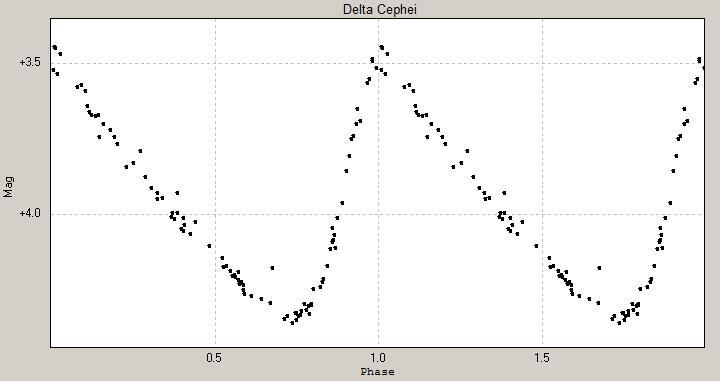
These variable stars were in the Large and Small Magellenic Clouds (remember the companion galaxies in Judy Faherty's birthday image?) so they could be assumed to be the same distance from us although we didn't know how far away they were. Fortunately some of these same variable stars (called Cepheids) were also foudn not too far away in our own galaxy where we could determine their distances using the previously described spectral techniques. These Cepheid stars were what gave us our initial indications that the Andromeda Galaxy and the Magellenic Clouds were too far away to be part of our own galaxy! RR Lyrae stars are another similar, though fainter, class of variable stars where their luminosity is predictable from the rate at which they vary in brightness.
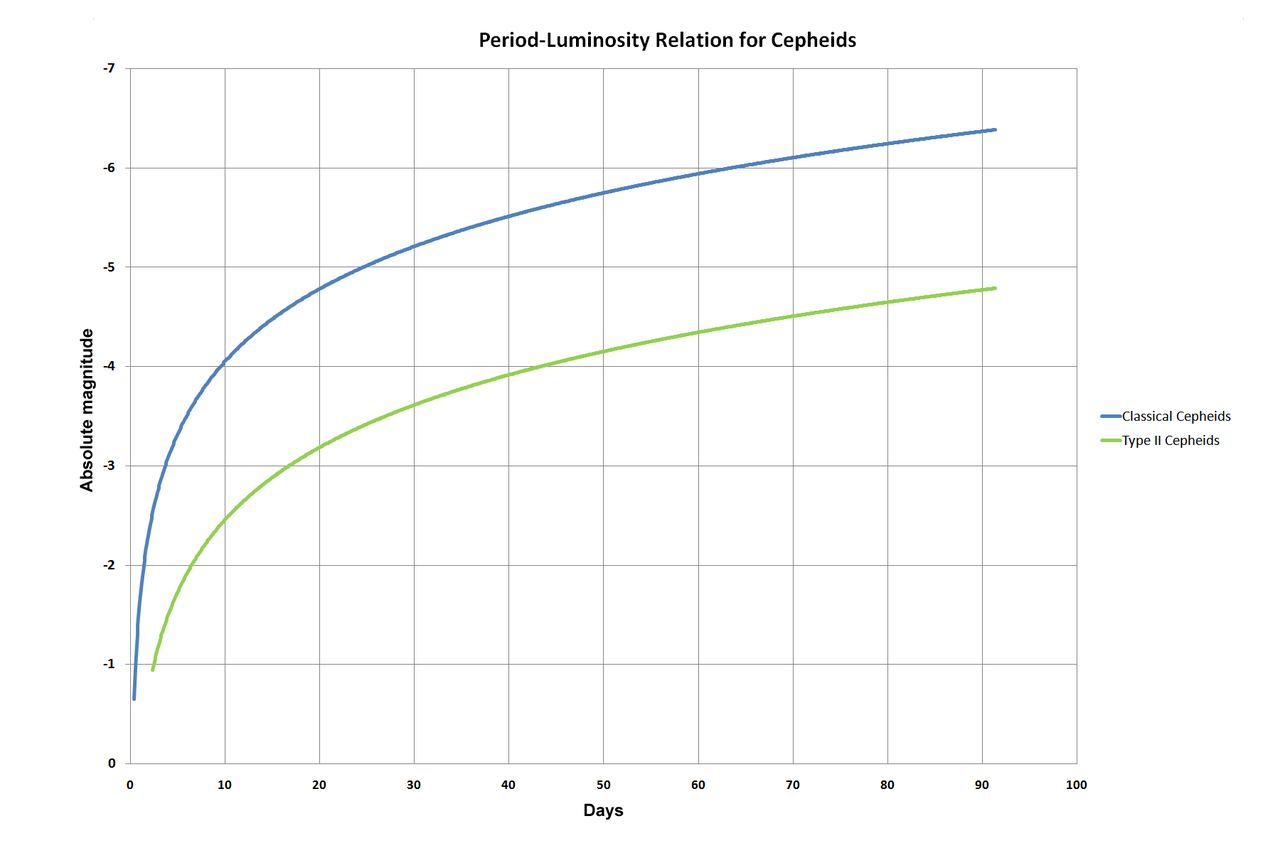
Cepheid stars in particular are so bright that we can see them in many nearby galaxies which ultimately allowed us to determine, using multiple stars, reliable distances to those galaxies.
An important thing to note about these first three steps in the distance ladder is that there are always some objects for which we can measure the distance using two or more techniques. Ultimately this provides both a cross check and a tool for connecting techniques that work at shorter distances with those that work at longer distances.

HW: Cosmology
Why is it important that the different tools we have for measuring distance overlap in their ranges of applicability? Why is it plausible that the brightest stars in any galaxy might also be a predictable tool for determining distances?
Novas and Supernovas:
Using Cepheid variables we are able to determine the distance to a reasonable number of galaxies. Because there are so many stars in a galaxy it becomes statistically likely that we will see stars go through the process of becoming nova or supernova. As we watched and accumulated data about nova and supernova we were able to identify certain patterns of peak brightness that were characteristic.
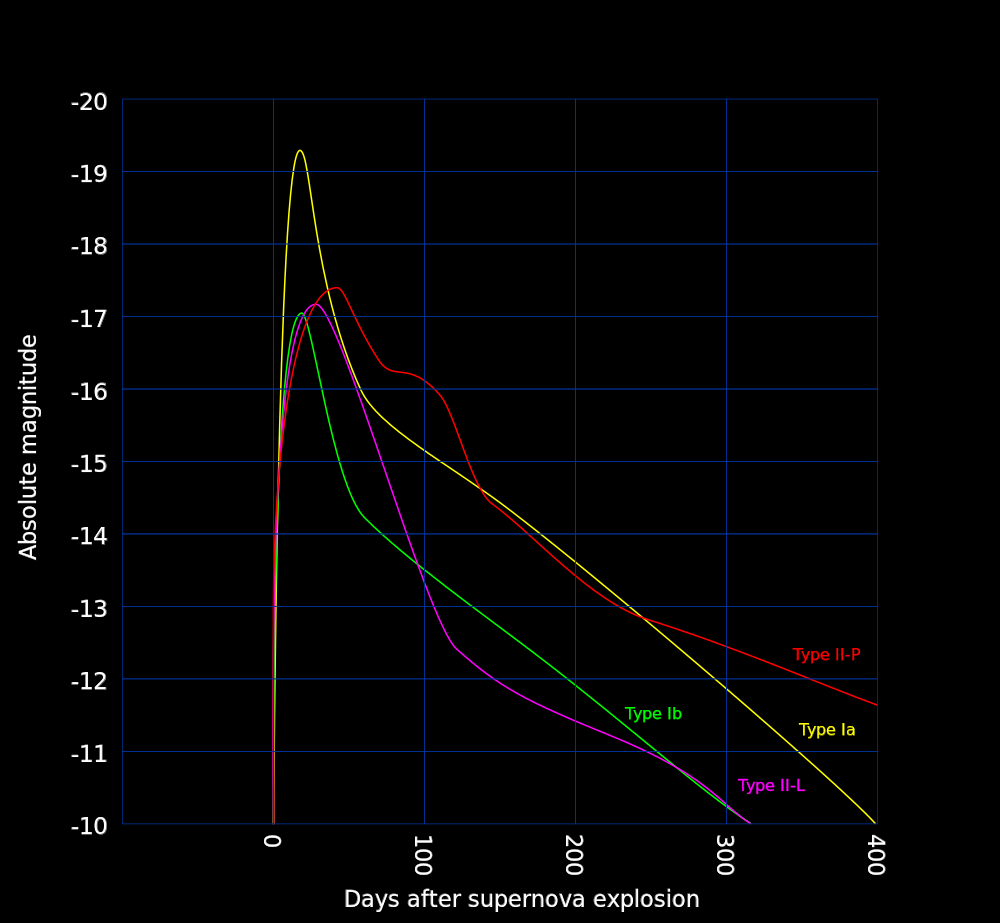
Thanks to Hans van Deukeren for use of the image
Because nova and supernova are many orders of magnitude brighter than any other objects in the galaxy we are able to see them, when they happen, much further away.
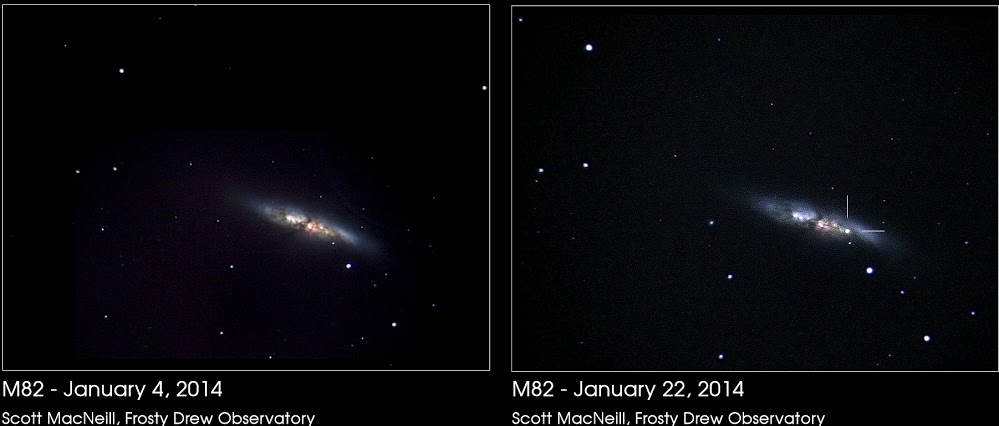
Hubble Flow:
As we were learning how to determine distances to other galaxies another feature of those galaxies was becoming apparent. When light, or any other wave, is emitted from a source that is moving the wavelength that we observe is changed. This is called the Doppler shift and is what you hear when an ambulance siren or a car horn goes by you. Here is a quick clip as an example.
The same effect shifts the wavelength and frequency of the spectral light coming from galaxies. As the source moves away from you the frequency drops and the wavelength gets longer. For light this means the light is being shifted towards the red end of the spectrum. Not surprisingly this is why it is called the redshift! From this we can extract the speed at which the galaxies are moving away from us. The fact that they are ALL moving away from us is a troubling observation that we will explore momentarily. This data is generally known as the Hubble flow for Edwin Hubble who was an early researcher in this field (1929). Here is what we know about the recession speeds as a function of distance for galaxies reasonable close to us.
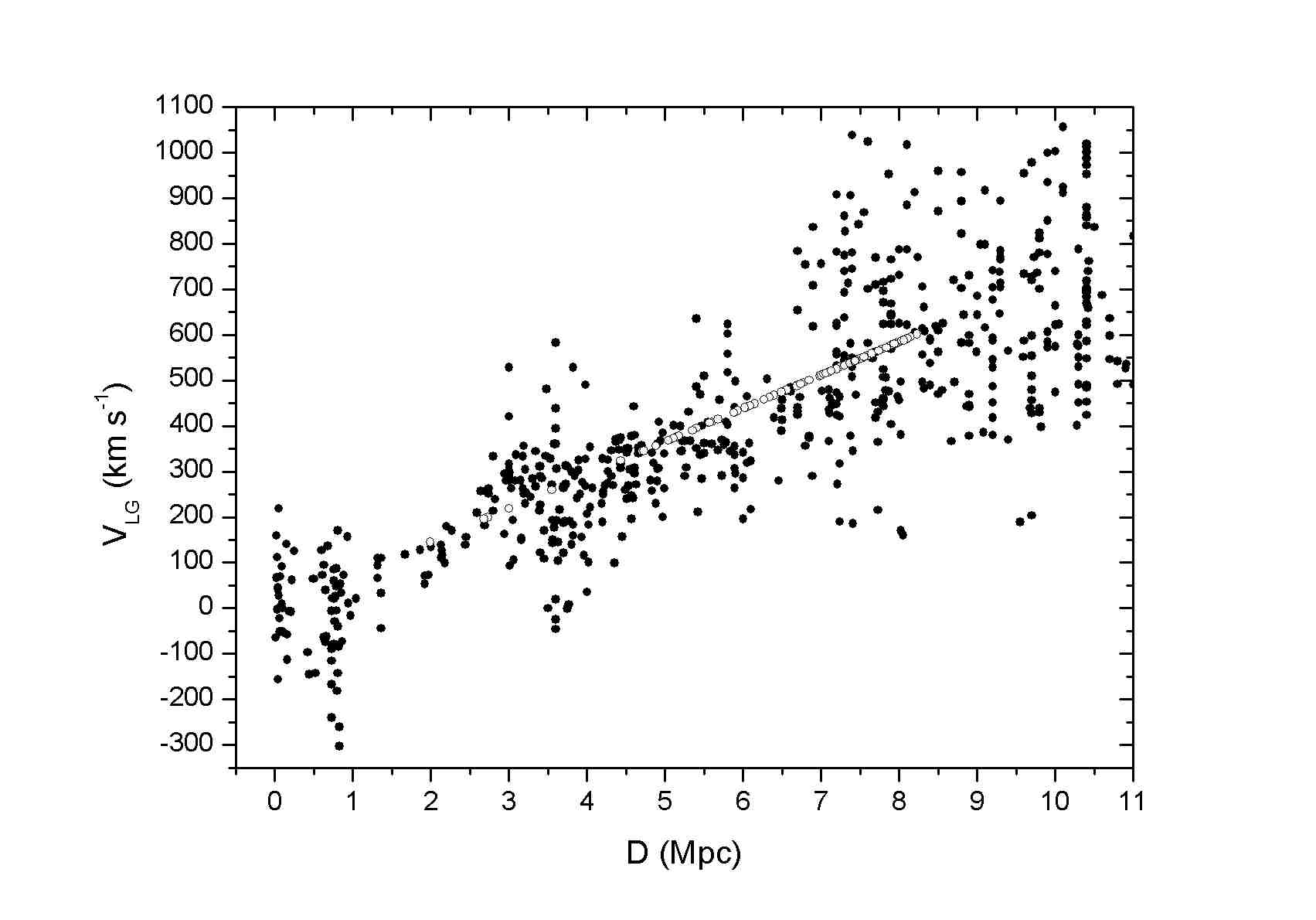
Like all real data it doesn't look particularly well behaved but there is a definite trend up and to the right. Remember that on this scale our nearest large galaxy (the Andromeda Galaxy) is 0.8 Mpc away. Over time we have used the distance tools we previously discussed to tighten up this distribution so the trend is more crisp. We now have a much richer picture with data that goes out much further.....
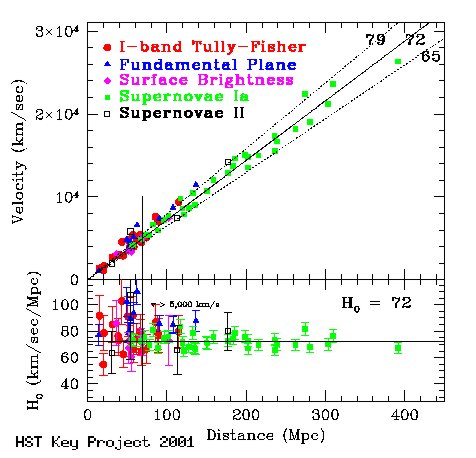
We now use this information to actually predict how far away an object is based on it's speed (measured as redshift).
HW: Cosmology
In a universe full of galaxies that formed from randomly moving clouds of gas why is it problematic that every galaxy we see in every direction is moving away from us? This is like walking through a park and discovering that everyone else is walking away from you even though you see dozens of people. Do you expect other people in the park to have the same experience you are having? This will be a good starting point for our next discussion.
Assignment: HW: Cosmology
Complete and assemble your solutions to all the HW problems listed here. Scan to a pdf and turn in on LMS. Please review HW format expectations for guidance about your homework solutions.
Reading Ahead:
Next time we will continue our explorations of the greater universe in the Cosmology II breadcrumb. This will support our discussion about the evolution of our universe.
